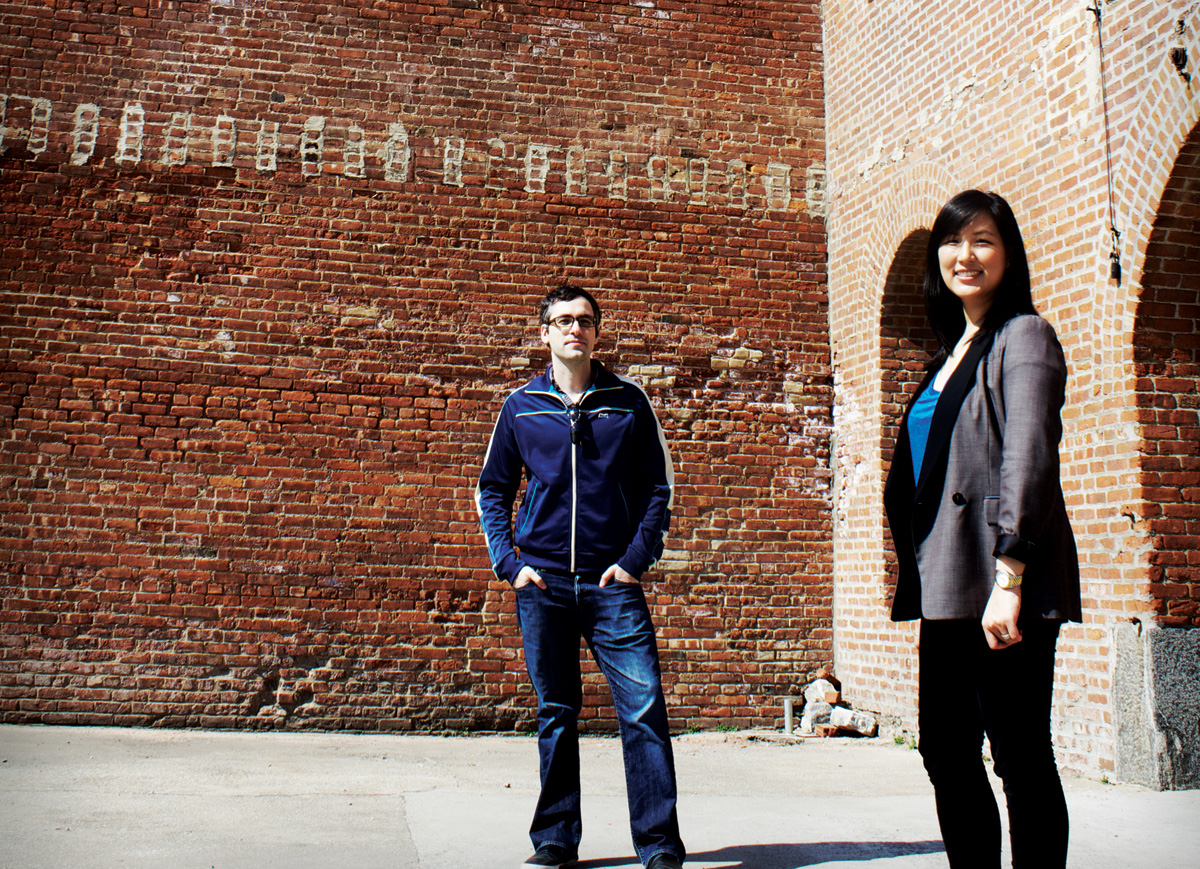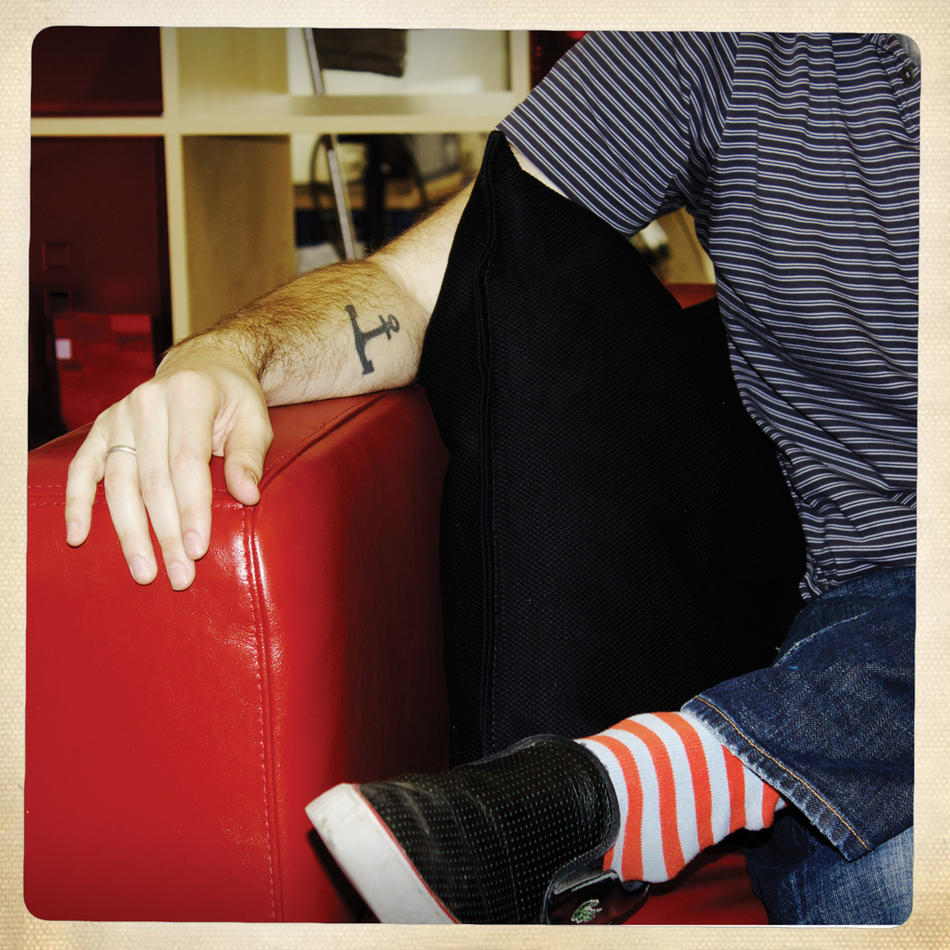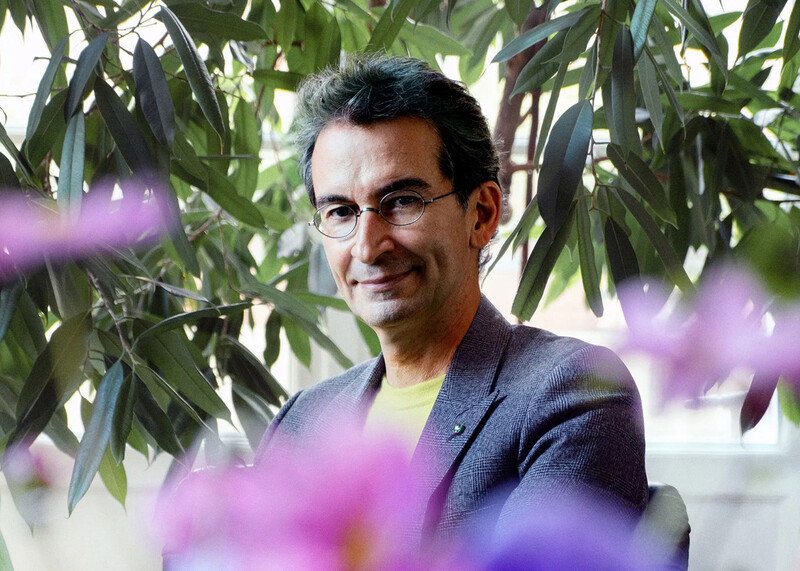
“A Bronx-bound D train was evacuated at West 4th Street early Friday morning after a suspicious passenger was discovered cowering under a seat. It was an opossum! Aw, isn’t it adorable? Well, no, not really; opossums are actually quite terrifying.” — Gothamist, January 2012
“The whole city smells like maple syrup and everyone knows it!” — Gothamist, October 2005
Eight million stories in the Naked City, sure. A Manhattan banker stabs a cabbie over a disputed fare, a car kills a bicyclist on Staten Island, the health department shutters a Queens hospital, Brooklyn sanitation workers get caught issuing bogus tickets. The Bronx? They closed down the Monkey House.
The other 7,999,995?
Step this way.
Maybe you, too, have heard the rumor, echoing in the corridors of the New York Times, that Jake Dobkin ’98CC and Jen Chung ’98CC, the dynamic duo behind the local news blog Gothamist, gather their wide-ranging NYC intel with the aid of a crystal ball. Crazy? We think so. But we’re not taking any chances. We’re getting on the F train to Brooklyn to see for ourselves. Stand clear of the closing doors, please.
Brooklyn! With a name like Gothamist and a logo of skyscrapers, we’d figured the blogcave would be wedged beneath a winged gargoyle in Midtown. Instead, we get off at York Street and emerge in a district of converted warehouses and new brick high-rises once known as Gairville but rebranded in the nineties as Dumbo, which stands for Developers Urge Millionaires to Brooklyn, Oh no! — or, more officially, Down Under the Manhattan Bridge Overpass. Names aside, Dumbo has become home to the smarties of New York’s tech startup community — companies like e-commerce upstart Etsy and branding consultancy Big Spaceship.
We walk down Jay Street to a nineteenth-century warehouse by the river, go inside, ride a packed elevator to the eighth floor, follow a long hallway to the door of Gothamist LLC, and step into a big, immaculate, sun-flooded office — the opposite of a cave. “Holy Front Page!” we murmur as we behold the true source of the blog’s omniscience: a dozen staffers in their twenties and thirties who sit at Ikea tables, pecking quietly at laptops. Not a crystal ball in sight. Nor any messy desks, bulletin boards, or ringing phones. Just large windows framing the girders and cables of the Manhattan Bridge, blond wood floors, and, on the white walls, color photographs of New York industrial landscapes, shot by Dobkin. In the clean, open kitchen, a small metal table holds a city of bottles: vodka, gin, Kahlúa, Purell.
Have we just entered the twenty-first-century newsroom?
Chung, Gothamist’s executive editor, strides cheerfully into the waiting area and greets us. Having settled the crystal-ball question, we wish to delve into another. Chung offers us water and leads us into a conference room, where an aerial photo of the World Trade Center construction site hangs on the wall. In a moment, Dobkin, Gothamist’s publisher, arrives. With his glasses and silver singe at the temples, he looks like the nice doctor he might have become had he stayed in medical school.
“Now, then,” we say, “since no business was ever born in a palace of sunlight, we must know: was there ever a blogcave?”
“In 2006,” says Chung, “I was working at an ad agency in SoHo. They had some extra office space that they let us sublet, so Jake and our operations person, Tien Mao, were able to take some cubicles.”
Blogcave!
“But we weren’t all together,” Chung continues. “We had writers working out of their apartments. Finally, in 2008, we got a small office in Dumbo so that we could be together and actually see each other, versus communicating just through e-mails and IMs.” Chung laughs. “Now, people sit right next to one another with headphones on and communicate by instant message.”
Gothamist moved into the present space last June. Between 2010 and 2011, the blog saw a 50 percent increase in unique visitors and a 100 percent increase in income. It now employs more than twenty people, including a sales staff and seven full-time New York editors who generate fifty posts a day on crime, politics, pop culture, restaurants, and urban wildlife. And just to be clear: this isn’t a blog written by wannabes from Podunk Hollow who wear Brooklyn T-shirts and don’t know a bodega from a deli.
“It’s not like I think you have to be a New Yorker to be a good person,” says Dobkin with a sly smile. “But to write about New York in an honest way, you really do have to understand the city.”
And to get to the eighth floor, you’ve got to know which of the eight million stories people care about. What drives Gothamist’s traffic most are the big social themes: gentrification, suburban-strip-mall-ization, police violence, the bicycle wars, Occupy Wall Street. “OWS was huge for us,” says Dobkin. “We were covering it probably a month before the major media because it was a youth thing — all the young people were there, and our audience and our writers were very interested in it, so when it did explode, we were right there on the scene. We had a lot of sources and got a ton of traffic from it.” A recent story on one of the Times’s neighborhood blogs mentioned Gothamist’s coverage of an OWS march:
Christopher Robbins, a reporter for Gothamist, tweeted about the arrest on 14th Street, as well as about another arrest involving a bottle hurled on Ninth Street between Avenues B and C: “Protester right next to me throws bottle, ducks down into crowd. NYPD swoop in, arrest wrong guy, thrower gets away.”
Readers of Gothamist would have gotten further context from reporter Robbins:
The instances of projectiles being thrown were met with scorn, outrage, and chants of “This is a peaceful protest” by a majority of the protesters. When a can and a bottle were thrown on 14th Street, the crowd was stunned into silence.
There have been other watersheds for the blog. Remember Hurricane Irene, when the city was going to be destroyed? Gothamist featured a map of evacuation zones and got tens of thousands of new visitors after the servers for NYC.gov and NY1.com both went down. But if you had to pinpoint Gothamist’s breakthrough, its CNN/Gulf War moment, it would have to be the Great Gotham Pancake Syrup Mystery. In October 2005, and sporadically in the following weeks and months, an odor suggestive of Mrs. Butterworth after a hot-yoga workout pervaded much of the city, and Chung’s breaking coverage of the phenomenon spread thickly through the blogosphere. Gothamist even whipped up a map so that people could identify the locations of the “smellings.” So central was Gothamist’s role in the affair that in 2009, when Mayor Bloomberg held a press conference at City Hall to announce, after years of investigation, the source of the smell (a fenugreek-seed processing plant in New Jersey), Chung was invited to attend.
One problem: real reporters don’t have to wait for invitations — a press pass is their entrée. Gothamist, with its history of original reporting, had been trying to get press credentials from the NYPD since 2004. After months of delays, the department informed Gothamist that websites weren’t eligible. It wasn’t until 2010 that Dobkin could even apply for what he calls “this basic tool of doing news.” He was rejected. The same thing happened in 2011. For another year, Gothamist was kept on this side of the barricades.
In the meantime, there were stories that the mainstream media weren’t covering that Gothamist could. “I’m always looking for a story with larger meaning than the story itself,” says Dobkin. “A bicyclist getting hit by a car: that may not sound like much, but it speaks to the conflict between young and old, rich and poor, people who bike and people who own cars. If a bicyclist is killed by a car in Williamsburg, it might not be news for the Times’s Metro section, because they have a news hole that can fit only twenty-five stories a day, but to us, it could be a real story. Who was the bicyclist? How did the accident happen?”
Gothamist doesn’t always have to look far for material. Half the blog’s content is aggregated from other sites and retold in the Gothamist voice, or else supplied by camera-toting tipsters, often in the form of some serendipitous video, such as a rat in a subway car running across a sleeping man’s face. “Recently, someone sent us a picture of a hawk in Madison Square Park eating a pigeon in the most disgusting way possible,” says Dobkin. “But what was remarkable was that he wasn’t the only person to send us that picture. We got it from three or four people. What are the chances?”
The rest of Gothamist’s goods are homegrown: photos, video, and on-the-scene reportage. Amid the spectacle, there’s also a strong public-interest aspect that can be traced to Gothamist’s birth in 2002, when Chung realized how little she knew about her city. “How many twenty-somethings in New York know who their city councilperson is?” she recalls thinking. So she educated herself, and now writes many of Gothamist’s pieces on crime and local politics, with headings like “Hello, Gerrymandering: NY’s Sucky Proposed Redistricting Maps Will Probably Get Vetoed” and “‘I Am Not the Catwoman,’ Wails Convicted Robber.” Posts usually run from one hundred to three hundred words.
“We can operate with a much faster metabolism than the Times or the Post,” Dobkin says. “We don’t have to be comprehensive. We have fifty posts a day, and we want all of them to be super-interesting. We want people to pass the information around.”
“It’s exciting to help spread information and empower people to know their city,” says Chung. She plucks some wisdom from her advertising days: “You want people to have a reaction to these stories. You want to hit emotions.”
“Gothamist’s voice is ‘We love the city,’” says Dobkin. “‘It’s not perfect, and when it’s imperfect we can talk about why. But it’s a great city, and we should all feel really lucky to live here.’ It’s a voice that is honest, positive, and sarcastic when called for, like the voice of a real New Yorker who knows the city and cares about it but who doesn’t tolerate bullshit, and who can enjoy a good joke.” Or, as Chung says, “It’s the voice of your most knowledgeable New York friend who’s going to give it to you straight.”
Not Jimmy Breslin barroom-wisdom-like-a-fist-through-cigar-smoke straight, though that’s the spirit. This voice has been cured not with Joe Mitchell’s gin, but with Onion satire, Vice saltiness, the sweet dust of Entertainment Weekly, the nutritional yeast of the Times, and the “roaringly funny gay wit,” as one Gothamist writer called it, of Village Voice gossip columnist Michael Musto ’76CC. (When Gothamist asked Musto in an interview how he’s had to adapt to the rise of gossip blogs like Gawker and Perez Hilton, the Gossipist replied, “Not at all, because I was sort of the original blogger anyway — I just didn’t have a blog. I was the original snarky, sardonic person.”)
Typical of Gothamist’s biting style and unapologetic New York chauvinism is the commentary of Gothamist managing editor John Del Signore, who performs the service of pointing out the un–New York character of spectacles like the worldwide No Pants Subway Ride (“We’ve had just about enough of this formulaic nonsense and want it to stop. Not because we’re against fun, but because New York City is fun enough without this inane exercise in half-assed exhibitionism”) and SantaCon, a national event whose local version brings thousands of young adults dressed as Kris Kringle to the bars, sidewalks, and eventually the gutters of Manhattan, starting at 10 a.m. “Over the years, this annual drunken shitshow has steadily devolved from cleverly subversive to barely tolerable to ‘time to lock yourself in your apartment for the day,’” Del Signore wrote. “Is it just us or was this year’s SantaCon even more obnoxiously fratastic than usual?”
As on many blogs, the comments section is a combination clubhouse, graffiti wall, jury room, and kill zone — a group exercise in venting and verbal marksmanship whose favorite targets are yuppies, hipsters, and out-of-towners. Race-baiters and other sociopaths turn up reliably to fling dung, but other exchanges can be illuminating: a discussion of the unsolved murder of a Brooklyn café owner reads like a postmodern detective novel, in which the shrewd deductions of armchair sleuths accumulate into an intriguing literary document, and a post about a forty-two-car police escort speeding up First Avenue to Bellevue after a cop was shot in Bushwick prompts audience tidbits on NYC trauma centers and the art of the rolling roadblock. And where else would a snarling subway marsupial be hailed as “one tough-ass NY ’possum,” since, as a reader points out, your average country opossum, when confronted, rolls over and plays dead?
Chung and Dobkin met at Columbia in 1995. Both were transfer students — Dobkin from SUNY Binghamton and Chung from Smith College, where she was friends with Jake’s twin sister, Molly. Jake and Jen became friends, and after college they and their circle would chat during the workday via e-mail and instant messaging. This was during the dot-com bubble of 1999–2001. Chung was doing brand consulting and marketing, and Dobkin, who had been premed at Columbia — and who, in 1999, attended the College of Physicians and Surgeons for ten days before deciding he wasn’t long for hospital life — was working as an IT consultant.
One day in early 2002, Dobkin saw a blog for the first time, a site called Kottke.org, run by the pioneering blogger Jason Kottke. Dobkin’s immediate thought was, “I’d like to do this.” So he created a personal website where he could post his photographs, writings, and links to things that interested him. Chung would leave comments and supply her own links. Other friends joined in. Dobkin, seeing potential, tracked down blogging software that allowed multiple authors to post on the same site. This was the great leap: Chung and others could now post their own items about goings-on about town. Later in 2002, Dobkin moved the blog to a new domain, which he named Gothamist. “The first year, it was still very casual and conversational, maybe ten or twenty of us posting links,” he says. “I was surprised that pretty quickly, into 2003, we started seeing a few thousand visitors a day.”
The following year, they landed their first ad, which paid for a new laptop for Chung. They got to know other New York bloggers and attracted a core of contributors who were willing to write for free. They also began to introduce the model to other cities. In 2005, Dobkin, having graduated from business school at NYU, decided he wanted to “do a startup” and make money. Gothamist was a fun hobby, but now Dobkin considered it from another angle. What if he devoted himself to it? Could Gothamist be the one? Dobkin called Chung, and the pair formalized a partnership. In June 2005, Dobkin went to work full-time on the blog. Chung, essentially working two jobs, quit her marketing gig in 2008 and committed herself wholly to Gothamist.
“We’ve been trying to build a real company, which you now see around you,” Dobkin says. “No one ever gave us any money. We paid for all this out of our profits.”
Gothamist now gets two million unique visitors per month. The Times, Gawker, Huffington Post, and thousands of other sites link to Gothamist regularly. The New York Times Book Review called the blog “marvelous, not-to-be-missed . . . a crystal ball that reflects everything worth knowing about this city.”
You can see how rumors get started.
Dobkin was born and raised in Brooklyn “around a lot of militant leftists — ex-Weathermen, hard-line Stalinists — the normal crowd you’d find at the Park Slope Food Co-op,” he says. His mother, an RN, works for the Nurse-Family Partnership in Harlem, and his father, a lawyer, defends the poor in housing cases. “Growing up, there was this idea that doing something meaningful and positive was much more important than making money. Making money was very much frowned upon.” Dobkin smiles, a little guiltily. “I’ve always had a complicated relationship with money. Very complicated.”
Chung, the daughter of a businesswoman and a civil engineer — immigrants from Hong Kong — seems less conflicted on that count. She grew up in northern New Jersey (“I always had New York envy”), and the family took frequent trips to the city: the Guggenheim, Radio City, and Chinatown for dim sum and groceries. At home, the Chungs received the New York Times and the local paper, as well as Time and Newsweek. Chung consumed it all. When she was thirteen, her parents bought her a subscription to a new magazine called Entertainment Weekly.
Now, in her thirties, Chung is costar of a media extravaganza that has traveled to nine other cities: there is an LAist, a DCist, a Chicagoist, a Shanghaiist. (None roll off the tongue as nicely as the original, and there is not yet a Minneapolisist.) For the three foreign sites (Shanghai, London, Toronto), Gothamist LLC gets a licensing fee in exchange for domain use and tech support. The US sites are run through the New York office, and the “-ists” of LA, Chicago, and San Francisco are the most popular independent blogs for those cities.
That’s a lot of crystal balls (actually, a lot of editors — another dozen full-timers outside New York), but, then, Chung and Dobkin have always had a big vision for the business. While they value their role as news aggregators (“It’s an essential function and always has been,” Dobkin says), what they’d really like is for Gothamist to become both the best aggregator and the best original news source. The dream got a little closer to reality this March, when Dobkin and reporter Robbins, with the help of former New York Civil Liberties Union director Norman Siegel, finally attained press credentials. You could almost hear the jitters at the Post.
“I’m a really big believer in original news, and increasingly, as we hire editors, we look for reporting experience,” says Dobkin. He smiles, and a wink of sunlight flashes in his glasses. “Imagine what we could do with twenty reporters.”







